Every year when the MLB All-Star team is selected there is controversy. Also inevitably every year there will be players on the team who we will never see again in an All-Star Game (Brett Cecil, you’re on notice). When looking back through the years there are plenty of head scratches as to why a player was ever deemed worthy of being an All-Star and this team I’ve assembled is the worst of the best.
The criteria used to choose this team was career Wins Above Replacement (WAR). Most of the players on this list had fairly lengthy careers but if you had seen them play you barely would have noticed them. I also try to figure out why these players were selected to an All-Star Game and I’ll focus on a traditional statistics to do so as most of theses selections happened decades ago before anyone cared about advanced statistics. In a couple of cases you can see why they were chosen given the circumstances but a few others are still head scratchers.
Catcher

Steve Swisher, 1976 Chicago Cubs
Career WAR: -1.9
During his career Swisher was primarily a platoon/back up catcher and saw his most extensive playing time during his All-Star season of ’76. He had a good defensive reputation but he never hit at all during his nine year career. His All-Star season was no different in that department as for the year he hit only .236/.275/.326.
Why was he selected as an All-Star?
Swisher was the lone Cubs rep and was hitting a respectable, for a catcher, .268 at the break but the Cubs weren’t exactly lacking in deserving candidates. Focusing on position players, third baseman Bill Madlock and center fielder Rick Monday both had fantastic seasons yet were snubbed. In Monday’s case he was likely squeezed out due to available outfield positions as the N.L. roster had four in reserve. That wasn’t the case at third base though as Ron Cey was selected as the lone reserve so an extra third baseman could have been taken. Madlock was never well liked during his career and it’s possible he was passed up for that reason. More likely N.L. manager Sparky Anderson felt he needed a third catcher and he would take an extra catcher the following year as well.
First Base
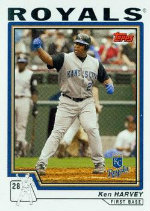
Ken Harvey, 2004 Kansas City Royals
Career WAR: -0.5
Harvey is the most recent player to make this team of Non-Stars. He had a trait that you didn’t really want out of a first baseman and that was he didn’t he hit for much power (career slugging .411). He only played one more season in the Majors after his All-Star season.
Why was he selected as an All-Star?
The Royals lost 104 games in 2004 so it’s not surprising they only had one selection but that didn’t necessarily make Harvey the right choice. He split time at first base and designated hitter with the Royals perpetually injured star Mike Sweeney but Sweeney was healthy midseason. Just looking at traditional stats Harvey was hitting .305 with 10 HR and 34 RBI at the break while Sweeney was hitting .279 with 16 HR and 57 RBI. A.L. manager Joe Torre must have been a bigger fan of batting average to have chosen Harvey over Sweeney. With all that being said it was a bizarre set of circumstances that lead to Harvey being the Royals rep in the first place. 2004 was the first year that players were involved in selecting the reserves and the A.L. players voted Carlos Beltran as a reserve. The problem was the Royals traded Beltran to the Astros the week before the players voted so he ended up on the N.L. squad.
Second Base
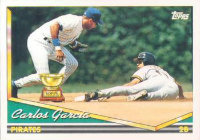
Carlos Garcia, 1994 Pittsburgh Pirates
Career WAR: 0.9
I’ve never been a fan of the one player per team rule. It’s an outdated rule that made a lot more sense when there were only eight teams in each league. But I do believe if they were ever to change that rule that the host team should still be required to have a rep so the local fans have someone to root for. Carlos Garcia happens to fit the criteria as he was the Pirates lone rep when they hosted the ’94 ASG. He could hit for a decent average and steal the occasional base but wasn’t much with the glove, not a lot of power, rarely drew a walk (115 in 2,359 plate appearances), and was often injured as well.
Why was he selected as an All-Star?
Pirates were in the early stages of their two decade long losing skid and there wasn’t a lot of star power on the team but there were more deserving candidates than Garcia who was hitting a hardly scintillating .267/.307/.332 at the break. The team’s best position player was shortstop Jay Bell but it was probably a numbers game at his position as Barry Larkin and Wil Cordero were selected as reserves. Probably the bigger snub when using traditional stats was veteran pitcher Zane Smith who was 9-6 with a 3.19 ERA at the break and unfortunately for him he never made an All-Star team. It seems Garcia’s selection as the Pirates rep came down to there what was perceived as a weak crop of second baseman options in N.L. that year as he was the lone reserve second baseman behind starter Craig Biggio. But there were a couple of deserving up and coming candidates in Jeff Kent (.284, 12 HR, 49 RBI at the break) and Bret Boone (.310, 5 HR, 49 RBI) but were passed over by N.L. manager Jim Fregosi.
Third Base
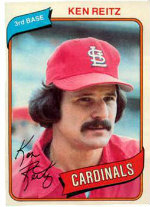
Ken Reitz, 1980 St. Louis Cardinals
Career WAR: -3.3
Maybe the question for Reitz shouldn’t be how he was selected as an All-Star but rather how was he the Cardinals regular third baseman for seven non-consecutive years? He was a terrible hitter (.260/.290/.359 for his career) and at least according to advanced defensive metrics was a mediocre third baseman. But reputation was a whole other matter as Reitz actually won a Gold Glove in 1975. He was the classic field everything that was hit right to him fielder but rarely got to anything that wasn’t hit right to him. His selection came in his 9th year in the Majors but only lasted two more after that.
Why was he selected as an All-Star?
Reitz has a unique distinction on this list as he actually started in the All-Star Game. Now he was not voted in as he replaced an injured Mike Schmidt in the line up. He also was not the lone rep for his team as well. The Cardinals won only 74 games in 1980 but they weren’t lacking in All-Stars with Keith Hernandez and George Hendrick also making the team. Reitz was hitting a solid .282 at the break but third base wasn’t exactly a weak position in the N.L. circa 1980. Ray Knight was the other third baseman to make the team but you also had the likes Ron Cey, Darrell Evans, Bill Madlock, and Bob Horner. Problem was Evans, Madlock, and Horner all had very poor first halves of the season and reality is All-Star rosters are pretty much always chosen based what you did so far in that season. Cey was hitting .260 with 12 HR and 36 RBI but this is 1980 so batting average was still king and Reitz got the nod over Cey.
Shortstop
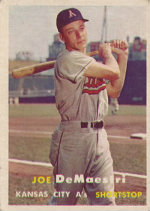
Joe DeMaestri, 1957 Kansas City Athletics
Career WAR: -3.9
DeMaestri has the unenviable claim to be the worst player ever to make an All-Star team, at least based on career WAR numbers. Of course players that rack up a negative number like that typically played a while and DeMaestri lasted 11 years, the majority of them as a regular. His career 62 OPS+ ranks among the worst of all-time.
Why was he selected as an All-Star?
While the one rep per team rule made more sense during this era the Kansas City A’s probably never should have had a rep. The best player on the A’s in ’57 was center fielder Woodie Held but he had missed the first two months of the season due to injury so he wasn’t an option. The only other potential candidate was third baseman Hector Lopez who was hitting .284 with 7 HR and 25 RBI at the break. Back then there were only nine reserve position players on the roster so there was really only one extra spot. Lopez would have been a much better choice to get that final spot but DeMaestri was hitting a slightly higher .288 so he was chosen.
Left Field
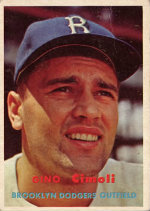
Gino Simoli, 1957 Brooklyn Dodgers
Career WAR: 1.3
Simoli is the answer to a trivia question: Who was the lead off hitter in the first MLB game played in California? He would get that honor the following season when the newly relocated Dodgers and Giants would square off on Opening Day. He struck out in that at bat and his ten year career in general was largely undisguised.
Why was he selected as an All-Star?
’57 was Simoli’s first full season in the Majors and he actually had a decent year. He was hitting .310 with 9 HR and 34 RBI at the break, pretty much the best he was at any point in his career, so his choice looks like it’s possibly defensible based on the traditional numbers. He was not the lone Dodgers rep as Gil Hodges and Clem Labine were also selected. There’s one player from the Dodgers though that is conspicuous by his absence and that his fellow outfielder Duke Snider. By his standards Snider did not have a great first half as he was hitting .272 with 16 HR and 41 RBI. Again batting average wins out in the selection process but doesn’t make it any less crazy that Duke Snider would be snubbed in favor Gino Simoli.
Center Field
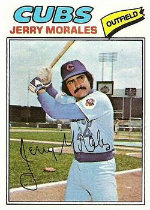
Jerry Morales, 1977 Chicago Cubs
Career WAR: -1.8
Morales wasn’t a terrible hitter but he was a terrible defensive outfielder, it’s any wonder how he fooled anyone into letting him play center field. He was also one of the worst base stealers of all-time as for his career stole 37 bases in 94 attempts for a putrid 39% success rate.
Why was he selected as an All-Star?
Morales’ season mirrored the Cubs season in 1977. He had a phenomenal first half with the bat hitting .331/.391/.502 while the Cubs were 19 games over .500 and in first place in the N.L. East. In the second half he hit .218/.269/.352 while the Cubs were 19 games under .500 and finished in fourth place. Morales was never as good as he was during the first half of ’77 but his selection was defensible under the typical All-Star selection criteria.
Right Field

Myril Hoag, 1939 St. Louis Browns
Career WAR: -3.3
Hoag had a 13 year career but the majority of it was as a reserve. He really did nothing particularly well outside of hitting for a respectable career batting average of .271 and was fortunate enough to pick up four World Series rings while playing with the Yankees.
Why was he selected as an All-Star?
Like with the Kansas City A’s it was usually hard to find a worthy All-Star rep for the St. Louis Browns, in particular the 1939 team which lost a franchise record 111 games. Amazingly though Hoag was not the Browns only selection as first baseman George McQuinn was also selected. Again this is when there were only eight teams in each league but it’s still remarkable a team that bad had multiple selections. I’m can’t confirm it but I think Hoag was a late replacement for injured Senators outfielder George Case. Hoag was hitting .319 at the break so his selection makes some sense until you realize that he was picked over Ted Williams! Williams was a rookie but he was hitting .343 with 14 HR and 68 RBI. It was probably some paying your dues nonsense as to why he wasn’t selected.
Starting Pitcher
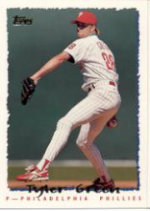
Tyler Green, 1995 Philadelphia Phillies
Career WAR: -1.0
Green was highly touted pitching prospect who flamed out quickly due to arm problems with some help from then manager Jim Fregosi’s overuse of him during the first half of his 1995 All-Star season. He made only 41 starts after that season.
Why was he selected as an All-Star?
Green’s selection was completely defensible. He was 8-4 with a 2.81 ERA going into the break and appeared to be a legitimate Rookie of the Year candidate. It was what transpired during the second half of the season and subsequently the rest of his career that makes him look like such an odd selection. In his last eight starts before the break his pitch counts were 137, 120, 110, 140, 110, 131, 131, and 109. This was a guy who had shoulder surgery just two years earlier. His arm was dead the rest of the year as he didn’t win another game, his ERA ballooned to 5.31, and he’d miss all of 1996 after another shoulder surgery.
Relief Pitcher
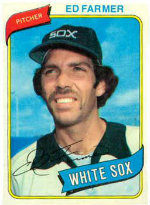
Ed Farmer, 1980 Chicago White Sox
Career WAR: 0.1
Farmer had a completely unremarkable 11 year career. Although ERA can be deceiving especially for relief pitchers its worth noting he had only three seasons with an ERA under 4. He also had very little command, walking 5 per 9 innings pitched in his career.
Why was he selected as an All-Star?
Farmer was the lone rep on a bad White Sox team and had 17 saves with a 3.00 ERA going into the break. The Sox did have two players who had very good years in 1980 in outfielder Chet Lemon and starting pitcher Britt Burns. Lemon had unimpressive numbers at the break hitting .264 with 6 HR and 29 RBI so it’s easy to see why he wasn’t chosen. Burns on the other hand as a rookie was 6-2 with a 3.09 ERA and would have been the better selection but A.L. manager Earl Weaver must have wanted another reliever.
Featured Photo Credit: AP

